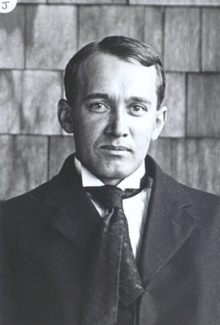Vesto Slipher
| Vesto Melvin Slipher | |
|---|---|
 V.M. Slipher (1875-1969). | |
| Born |
November 11, 1875 Mulberry, Indiana |
| Died |
November 8, 1969 (aged 93) Flagstaff, Arizona |
Resting place | Citizens Cemetery, Flagstaff |
| Nationality | American |
| Occupation | Astronomer |
| Employer | Lowell Observatory |
| Known for | Expanding universe |
| Relatives | Earl C. Slipher (brother) |
Vesto Melvin Slipher (November 11, 1875 – November 8, 1969) was an American astronomer who performed the first measurements of radial velocities for galaxies, providing the empirical basis for the expansion of the universe.[1] [2]
Slipher was born in Mulberry, Indiana, and completed his doctorate at Indiana University in 1909.[1] He spent his entire career at Lowell Observatory in Flagstaff, Arizona, where he was promoted to assistant director in 1915, acting director from 1916, and finally director from 1926 until his retirement in 1952.[1] His brother Earl C. Slipher was also an astronomer and a director at the Lowell Observatory.
Slipher used spectroscopy to investigate the rotation periods of planets and the composition of planetary atmospheres. In 1912, he was the first to observe the shift of spectral lines of galaxies, making him the discoverer of galactic redshifts.[3] In 1914, Slipher also made the first discovery of the rotation of spiral galaxies. [4] He discovered the sodium layer in 1929.[5] He was responsible for hiring Clyde Tombaugh and supervised the work that led to the discovery of Pluto in 1930.[1]
Edwin Hubble is commonly incorrectly credited with discovering the redshift of galaxies;[6] these measurements and their significance were understood before 1917 by James Edward Keeler (Lick & Allegheny), Vesto Melvin Slipher (Lowell), and William Wallace Campbell (Lick) at other observatories.
Combining his own measurements of galaxy distances with Vesto Slipher's measurements of the redshifts associated with the galaxies, Hubble and Milton Humason discovered a rough proportionality of the objects' distances with their redshifts. This redshift-distance correlation, nowadays termed Hubble's law, was formulated by Hubble and Humason in 1929 and became the basis for the modern model of the expanding universe.
Slipher died in Flagstaff, Arizona[1][7] and is buried there in Citizens Cemetery.
Awards
- Lalande Prize (1919)[1]
- Gold Medal of the Paris Academy of Sciences (1919)[1]
- Henry Draper Medal of the National Academy of Sciences (1932)[1][8]
- Gold Medal of the Royal Astronomical Society (1932)[1][9]
- Bruce Medal (1935)[10]
- The crater Slipher on the Moon is named after Earl and Vesto Slipher, as is the crater Slipher on Mars and the asteroid 1766 Slipher, discovered September 7, 1962, by the Indiana Asteroid Program.
Notes
- ↑ 1.0 1.1 1.2 1.3 1.4 1.5 1.6 1.7 1.8 "Nesto (sic) Slipher, 93, Astronomer, Dies". The New York Times (Flagstaff, AZ, published November 10, 1969). November 9, 1969. p. 47. ISSN 0362-4331
- ↑ Way, M.J., and D. Hunter (Eds.) (2013). Origins of the Expanding Universe: 1912-1932. ASP Conference Series 471. Astronomical Society of the Pacific.
- ↑ Slipher first reports on the making the first Doppler measurement on September 17, 1912 in The radial velocity of the Andromeda Nebula in the inaugural volume of the Lowell Observatory Bulletin, pp.2.56-2.57. In his report Slipher writes: "The magnitude of this velocity, which is the greatest hitherto observed, raises the question whether the velocity-like displacement might not be due to some other cause, but I believe we have at present no other interpretation for it." Three years later, Slipher wrote a review in the journal Popular Astronomy, Vol. 23, p. 21-24 Spectrographic Observations of Nebulae, in which he states, "The early discovery that the great Andromeda spiral had the quite exceptional velocity of - 300 km(/s) showed the means then available, capable of investigating not only the spectra of the spirals but their velocities as well." Slipher reported the velocities for 15 spiral nebula spread across the entire celestial sphere, all but three having observable "positive" (that is recessional) velocities.
- ↑ Slipher, Vesto (1914). "The detection of nebular rotation". Lowell Observatory Bulletin, 62.
- ↑ http://www.albany.edu/faculty/rgk/atm101/sodium.htm
- ↑ This had actually been observed by Vesto Slipher in the 1910s, but the world was largely unaware of this. Ref: Slipher (1917): Proc. Amer. Phil. Soc., 56, 403.
- ↑ Giclas, Henry L. (2007). "Slipher, Vesto Melvin". In Hockey, Thomas et al. Biographical dictionary of astronomers. vol. II, M-Z. Springer. p. 1066.
- ↑ "Henry Draper Medal". National Academy of Sciences. Retrieved 24 February 2011.
- ↑ "Winners of the Gold Medal of the Royal Astronomical Society". Royal Astronomical Society. Retrieved 24 February 2011.
- ↑ "Past Winners of the Catherine Wolfe Bruce Gold Medal". Astronomical Society of the Pacific. Retrieved 24 February 2011.
External links
- Library of Lowell Observatory: Biography of V. M. Slipher
- The Royal Observatory, Edinburgh: History, Papers & External Links on V. M. Slipher
- Vesto Melvin Slipher at Find a Grave
- V. Slipher @ Astrophysics Data System
|